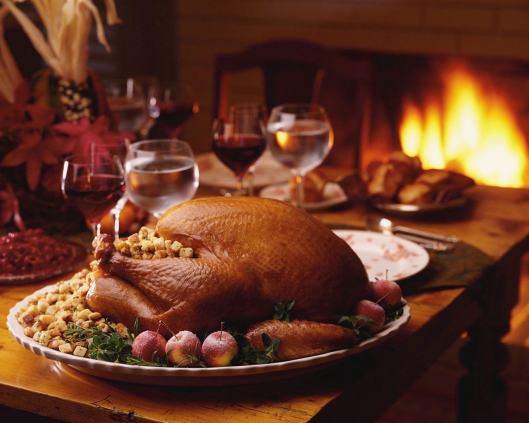For those who haven’t studied historic foods, a bubbly-jock is a turkey – that traditional bird of the holiday table. To be precise, it is a turkey-cock, and it has been found on Scottish tables since the 17th century, and probably before. A meal served in the presence of King James I while on his way to Scotland included roast turkey in 1617. In the Calendar of State Papers as related to Scotland and Mary Queen of Scotts, is found mention of “turkey cockis”.
References are found in early Scottish publications to a person acting as a bubbly-jock. Such is to ridicule someone whose behavior resembles the strutting and noisy displays of a male turkey. For those who have seen a male turkey drop his wings, fan out his tail, ruffle his feathers, and make his drumming sound, the reference will be abundantly clear.
The term bubbly-jock dates from at least as early as the 1700’s. Earlier references from the Scottish Historical Review talk about a “twrkie” [1671] or “turkie cock” [1688], therefore, Outlander fans may wisely choose to serve a, “roastit bubbly-jock” for Christmas dinner this year.
For an idea what was served with the roastit bubbly-jock we look to Susanna MacIver [1789]. She operated a cooking school from her home in Edinburgh during the 18th century. Her “Cookery and Pastry” as taught and practiced by Mrs. MacIver was first published in 1773. She claimed to have frequently made every dish in the book. Not much else is known about her except Florence White said in “Good Things in England” that her father was an impoverished Highland laird. She sold the book from her home for use by the middle and upper classes. The Bills of Fare were added after the first edition at the request of her students and were mere suggestions of what one might find in a dinner served in courses.
In one Bill of Fare she suggested boiled pork, roast turkey, greens, soup, and pease pudding. For a more elaborate dinner with roast turkey she advised potatoes, pickles, and stewed celery along with jugged hare, saddle of mutton, and a variety of tarts and puddings.
Vegetables she included in her Bills of Fare with other meats, and which many a maid or housewife may have served up with turkey as well, included kidney beans, broccoli, spinach, peas, carrots, salad, cauliflower, mushrooms, stewed lettuce and peas, asparagus, artichokes, and sorrel with poached eggs. In her list of garden fare she listed additionally coleworts, sprouts, cardoons, parsnips, turnips, endive, leeks, cresses, mustard, onions, beets, salsify, scorzonera, Jerusalem artichokes, purslane, radishes, cucumbers, cabbages, skirrets, “all sorts of small salad”, and a long list of pot herbs.
Before one might enjoy, “a bubbly-jock garnished with links of sausages”, the cook might boldly ask, “have ye killed the auld bubbly-jock, as ye threatened this morning?” Once the bird has been dispatched and cleaned it would have been prepared as follows or it was often boiled, especially if the turkey was older and tougher than might be desired.
Mary Eaton instructed her readers to stuff the turkey with sausage meat unless sausages were to be served separately in a dish in which case it could be stuffed with bread stuffing. “As this makes a large addition to the size of the fowl, observe that the heat of the fire is constantly to that part for the breast is often not done enough. A little strip of paper should be put on the bone, to prevent its being scorched while the other parts are roasting. Baste it well…serve with gravy in the dish and plenty of bread sauce in a sauce tureen. Add a few crumbs and a beaten egg to the stuffing of sausage meat.”
TO ROAST TURKEY POU[L]TS. Mary Smith. “The Complete House-keeper”. 1772. Newcastle.
Take young turkeys, rather larger than a half-grown fowl, scald and draw them clean, skewer them with their heads down to their sides, spit them, and lay them down to a clear fire for twenty minutes; baste them well with butter, and dust them with flour, let them be plump, and of a nice brown, lay them in a dish, with some brown gravy under them, and serve them up hot for a second course, with some bread sauce in a boat.
For the BREAD SAUCE.
Put the crumbs of a halfpenny roll into a sauce-pan with some water and some peppercorns, one onion cut in slices, two ounces of butter, let it boil ‘till the bread is soft, beat it up, and add three spoonfuls of thick cream to make it white, let it just simmer, pour it in a boat, and serve it up. This is a proper sauce for roast turkey, pheasant, or partridge.
Merry Christmas, Happy New Year, & may God Bless.
– TheHistoricFoodie is a copyrighted site.©
See:
Galt, John. “The Last of the Laird”. 1826. Edinburgh.
“Tait’s Edinburgh Matazine. Oct. 1834.
Whittle, Peter. “A Topographical, Statistical, & Historical Account of the Borough of Preston”. 1821. Preston.
Eaton, Mary. “The Cook and Housekeeper’s Complete and Universal Dictionary”. 1822. Bungay.
MacIver, Susannah. “Cookery and Pastry”. 1789. London.


You must be logged in to post a comment.